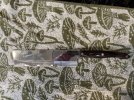Hi Everyone,
My name is Jim, and I’m recently retired. Over the past year, I’ve been deeply immersed in collecting and sharpening knives, and I’d love to hear any feedback or insights you might have. I thought I’d share my sharpening setup and some of the key things I’ve learned so far.
Sharpening Equipment
What I’ve Learned
I’ve been soaking up as much knowledge as possible—reading, watching videos, and recently working through Dr. Vadim Kralchuk’s book, "Knife Deburring: Science Behind the Lasting Razor Edge." After incorporating what I’ve learned and using the Slipakniven 250mm felt wheel, I feel like I’m finally achieving respectable BESS scores.
I’d love to hear thoughts from other sharpeners and what their favorite knives are! Any tips or techniques that have helped you refine your edge performance?
My name is Jim, and I’m recently retired. Over the past year, I’ve been deeply immersed in collecting and sharpening knives, and I’d love to hear any feedback or insights you might have. I thought I’d share my sharpening setup and some of the key things I’ve learned so far.
Sharpening Equipment
- I use a Tormek T-8 system with the following wheels:
- Diamond wheels – DC, DF, and DE
- Conventional wheels – SB, SG, and SJ
- Felt honing wheels – Two 250mm Sliipakniven rock-hard felt wheels, one with 1µm diamond spray and the other with 6µm
- Leather honing wheel – 250mm with 0.025µm diamond + Cr203 paste
- Slipakniven Front Vertical Base (FVB) Knife jig set & software Three different size Universal Support Bars (USBs)
- Digital calipers – 8” for USB/FVB measurements, 12” for wheel diameters
- Slipakniven Laser Goniometer
- Edge-On-Up Professional Edge Tester
| Benchmade | Mini Crooked River | S90V |
| Benchmade | Osborne BC | Magnacut |
| Civivi | Mini Praxis | Damascus |
| Civivi | Praxis | Damascus |
| Dexter | Filet | SG133-7 |
| Kershaw | 1776GRYDAM | Damascus |
| Kershaw | Launch 14 7850 | CPM154 |
| Kershaw | Leek 1660 | 14C28N |
| Kershaw | Leek 1660CU | CPM154 |
| Shun | Classic 8" Chef's Knife | VG-MAX |
| Spyderco | Manix 2 (Pinned Light) | S110V |
| Zero Tolerence | 0562TI | CPM 20CV |
| Zero Tolerence | 0770CF | S35VN |
What I’ve Learned
I’ve been soaking up as much knowledge as possible—reading, watching videos, and recently working through Dr. Vadim Kralchuk’s book, "Knife Deburring: Science Behind the Lasting Razor Edge." After incorporating what I’ve learned and using the Slipakniven 250mm felt wheel, I feel like I’m finally achieving respectable BESS scores.
I’d love to hear thoughts from other sharpeners and what their favorite knives are! Any tips or techniques that have helped you refine your edge performance?


